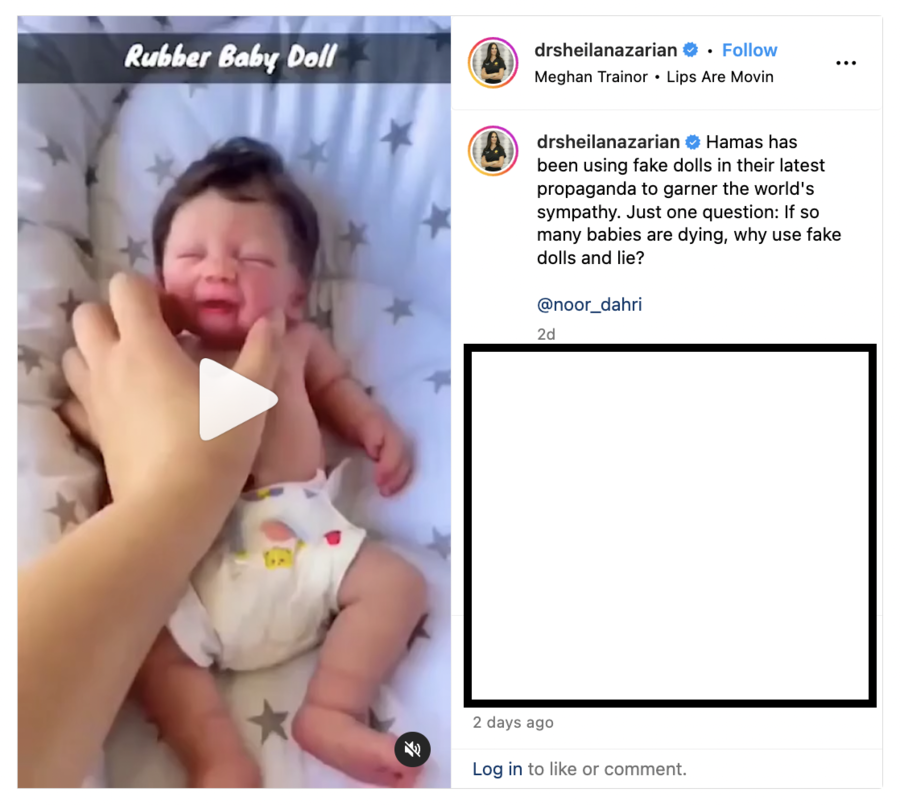
Does a video on social media provide evidence that Hamas has been staging civilian casualties in Gaza by filming rubber dolls that look like real babies? No, that's not true: The video reused on social media was first posted months before the 2023 Hamas-Israel conflict. Neither the footage nor the pre-war post said anything about Gaza.
The claim appeared in a post (archived here) on Instagram on December 3, 2023. It opened:
Hamas has been using fake dolls in their latest propaganda to garner the world's sympathy. Just one question: If so many babies are dying, why use fake dolls and lie?
@noor_dahri
The post included a video with an upper banner saying:
Rubber Baby Doll.
This is what the post looked like on Instagram at the time of writing:
(Source: Instagram screenshot taken on Tue Dec 5 21:05:37 2023 UTC)
The entry mentioned a different account on Instagram that had published a variation (archived here) of the claim stating that Hamas managed to import "hundreds" of such reborn dolls from China, allegedly paying $60 per item.
Neither of the two posts on Instagram included any frame-by-frame analysis confirming that these specific dolls were seen in any current war-related footage. They did not provide any independently verifiable links or references to official sources or credible media organizations, either.
A reverse image search showed that the "Rubber Baby Doll" video was published (archived here) almost five months before Hamas attacked Israel, on May 10, 2023. That post said nothing about any wars:
(Source: TikTok screenshot taken on Tue Dec 5 21:22:04 2023 UTC)
The footage showed a person squeezing the heads of hyper-realistic baby dolls, and the hashtags specifically referred to medical dolls.
Interestingly, a single, 7-year-old English-language mention (archived here) of dolls on the Israel Defense Forces (IDF) website also concerned medical dolls:
Since October 2015, the Central Command's Medical Corps have been simulating scenarios and treatments after an attack. However, they don't treat traditional patients. They use plastic dolls whose circulatory and respiratory systems resembled those of human beings. With the help of cutting-edge technology, they respond to the treatment they receive - as humans would. This enables medical officials to constantly improve their methods under intense pressure.
Images published by the Times of Israel in 2016 (archived here) only showed dummies portraying adults, and it remains unclear whether Israel has ever expanded the program to include dolls mimicking children's responses since then.
While medical dolls are designed to replicate human anatomy, they tend to look more like mannequins, not hyper-realistic representations of people.
The toys, which bear an outstanding degree of resemblance to human babies, are called reborn dolls. This product was covered by New York Magazine's The Cut (archived here.)
At first limited to a few enthusiasts, reborn dolls started to gain popularity in the United States in the 1990s. By the mid-2000s, such dolls were not only custom-made by individual artists but also produced by larger companies. Some of the reborns are even equipped with such features as a heartbeat sound.
Yet, the existence of these hyper-realistic dolls elsewhere does not automatically prove their presence in Gaza or that the other videos from the area show dummies, not injured or killed children.
The footage showing the first doll from the reused video on Instagram was published on social media even earlier, on January 11, 2023:
This longer video said that the item was an expensive custom-made collectible, not a mass-produced $60 toy that can be imported in "hundreds":
Hamas-controlled Gaza's Ministry of Health has said (archived here) that over half the deaths are women and children. While the exact death toll cannot be immediately independently verified during the war, the estimate suggesting that these groups were disproportionately affected has been widely used by the United Nations, whose subagencies have a considerable humanitarian presence in the area, running as many as 183 schools. Catherine Russell, executive director of the United Nations Children's Fund (UNICEF), specified (archived here) that 40 percent of deaths in Gaza were children.
The estimates suggesting that younger populations may be the most affected in Gaza do not contradict well-known facts about its pre-war population: Almost 40 percent of the people living in the territory were below the age of 15 in 2023, according to the CIA World Factbook (archived here.)
As of this writing, there have been no official reports or news articles (search archived here) about the Israeli Defense Forces discovering storage of reborn dolls during any stages of the ground operation in the area.
The claim that is the focus of this fact check appeared on social media the day after the Jerusalem Post had retracted (archived here) an article that said that one particular video from Gaza showed a doll, not a dead baby.
Lead Stories previously debunked multiple claims about purportedly staged war-related scenes in Gaza.
Other Lead Stories fact checks about the 2023 Hamas-Israel conflict can be found here.


















